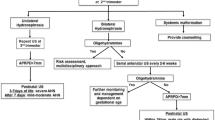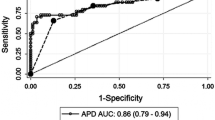Abstract
Aim
To determine the role of antenatal parameters in predicting the outcome of bilateral fetal hydronephrosis.
Methodology
Total 50 antenatal women with bilateral antenatal fetal hydronephrosis (ANH) were included. On ultrasound, amount of liquor, kidney size, pelvic anteroposterior diameter, degree of caliectasis, bladder size, and thickness were observed at 28 and 32 weeks of gestation. For 3 months post-delivery, the babies were evaluated in terms of ultrasound renal parameters, serum creatinine levels, and need for surgery.
Results
The mean gestational age at delivery was 37.4 ± 1.7. All babies were alive at birth, 48 were alive after 3 months. Surgery was done in 10/50 cases; cystoscopic fulguration was the most common procedure. There was a resolution of bilateral ANH in 27/50 cases, in 5/50 cases there was pylectasis with normal serum creatinine, and in 18/50 cases there was adverse outcome. Most of the parameters had better sensitivity and specificity at 32 weeks than at 28 weeks. At 32-week gestation, the renal pylectasis between 10 and 15 mm had the highest sensitivity (88.9%), and the presence of caliectasis had the highest specificity (90.6%) for adverse outcome.
Conclusion
Resolution of hydronephrosis took place in the majority of cases, and there was an adverse outcome in only one-third of them. Renal caliectasis was the best marker for the prediction of adverse outcome.

Similar content being viewed by others
References
Plevani C, Locatelli A, Paterlini G, et al. Fetal hydronephrosis: natural history and risk factors for postnatal surgery. J Perinat Med. 2014;42(3):385–91.
Kumar M, Thakur S, Puri A, Shukla S, et al. Fetal renal anomaly: factors that predict survival. J Pediatr Urol. 2014;10(6):1001–7.
De Paula PG, Bunduki V, Hase EA, et al. Prenatal natural history of isolated fetal mild bilateral pyelectasis. Clinics (Sao Paulo). 2016;71(9):511–6.
Kaspar CDW, Lo M, Bunchman TE, et al. The antenatal urinary tract dilation classification system accurately predicts severity of kidney and urinary tract abnormalities. J Pediatr Urol. 2017;13(5):485.e1–.e7.
Chalmers DJ, Meyers ML, Brodie KE, et al. Inter-rater reliability of the APD, SFU and UTD grading systems in fetal sonography and MRI. J Pediatr Urol. 2016;12:305.
Fernbach SK, Maizels M, Conway JJ. Ultrasound grading of hydronephrosis: introduction to the system used by the Society for Fetal Urology. Pediatr Radiol. 1993;23:478e80.
Zanetta VC, Rosman BM, Bromley B, et al. Variations in management of mild prenatal hydronephrosis among maternal-fetal medicine obstetricians, and pediatric urologists and radiologists. J Urol. 1935e;188:1935e9.
Nguyen HT, Benson CB, Bromley B, et al. Multidisciplinary consensus on the classification of prenatal and postnatal urinary tract dilation (UTD classification system). J Pediatr Urol. 2014;10(6):982–98.
Nguyen HT, Herndon CD, Cooper C, et al. The Society for Fetal urology consensus statement on the evaluation and management of antenatal hydronephrosis. J Pediatr Urol. 2010;6:212–31.
Bondagji NS. Antenatal diagnosis, prevalence and outcome of congenital anomalies of the kidney and urinary tract in Saudi Arabia. Urol Ann. 2014;6(1):36–40.
Afroz R, Shakoor S, Salat MS, et al. Antenatal renal pelvic dilatation and foetal outcomes—review of cases from a tertiary care center in Karachi, Pakistan. J Pak Med Assoc. 2016;66(12):1597–601.
Klener TA, Wohlmuth C, Schimke C, et al. Ultrasound Markers in Fetal Hydronephrosis to Predict Postnatal Surgery. Ultraschall Med 2018 Jul 5
Darwish HS, Habash YH, AlMardawi EA, et al. Postnatal outcome of isolated antenatal hydronephrosis. Saudi Med J. 2014;35(5):477–81.
Dos Santos J, Parekh RS, Piscione TD, et al.. A new grading system for the management of antenatal hydronephrosis. Clin J Am Soc Nephrol. 2015;10(10):1783–90.
Funding
There is no funding from any source for the study.
Author information
Authors and Affiliations
Corresponding author
Ethics declarations
Conflict of interest
There is no conflict of interest among authors to disclose.
Ethical Statement
The research involved human participants and informed consent was taken before enrolment in the study.
Additional information
Publisher's Note
Springer Nature remains neutral with regard to jurisdictional claims in published maps and institutional affiliations.
Priyanka Shukla, Resident, Department of Obstetrics and Gynecology, LHMC, New Delhi; Manisha Kumar, Professor, Department of Obstetrics and Gynecology, LHMC, New Delhi; Archana Puri, Professor, Pediatric surgery, KSCH, New Delhi; Siva PM, Assistant Professor, Dept of community medicine, TVMCH, Tirunelveli.
Rights and permissions
About this article
Cite this article
Shukla, P., Kumar, M., Puri, A. et al. Correlation of Antenatal Ultrasound Parameters with the Postnatal Outcome of Bilateral Fetal Hydronephrosis. J Obstet Gynecol India 70, 202–207 (2020). https://doi.org/10.1007/s13224-020-01318-4
Received:
Accepted:
Published:
Issue Date:
DOI: https://doi.org/10.1007/s13224-020-01318-4




